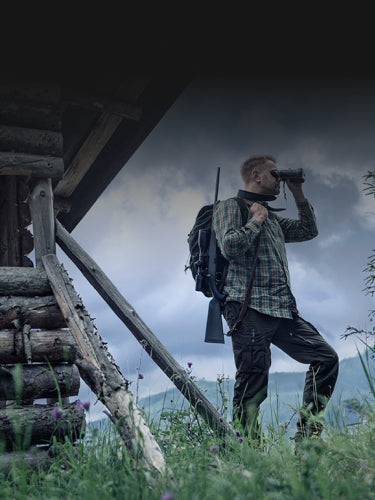Wild hog hunting is a multi-million-dollar industry. It is estimated that $10.5 million a year is spent a year alone on Texas hog meat, firearms and accessories – and ammo manufacturers are capitalizing on that. The more specialized gear we have available to shoot hogs easier and more humanely, the better for all of us!
“They’re like gigantic rats. But at least they’re edible.” -Texas Chef Tim Love
Though there are many good hog hunting guns, we prefer MSR-style rifles because they come in a variety of knock-down calibers, are incredibly adaptable and are just plain fun to shoot for a hunting experience. Wild boars are considered an exotic species and therefore, here in Texas, have virtually no restrictions in regards to hunting them on public or private land.
As always, check with local officials and regulations before engaging in any hunting behavior.
MSRs, SBRs, even fully automatic systems can be set up with suppressors, night vision and thermal imaging, as well as lasers and hog lights. In Texas, we can shoot as many hogs as we want, 360 days a year, all day and all night. Fortunately, the AR-15 and AR-10 style platforms come in a wide variety of hog-hunting calibers.
When hunting any animal, you need to choose a caliber with enough oomph—ideally in one shot—to take that animal down. The bigger and tougher the animal, the bigger and tougher the caliber should also be.
The right caliber, bullet and shot placement are basic elements to a successful hog hunt. But what is the right caliber?
The answer is obviously subjective but here are some of our favorites.
.223 Remington
.223 Remington, the traditional caliber for an AR-15, is popular due to its availability and affordability. It is also reloadable and bullet technology and ballistic advancements have led to ammo designed to take down varmints and predators quite efficiently.
Lightweight and with very low recoil, the .223 Remington/5.56mm AR is easy for all levels of hunters to carry in the field, as well as operate. Many a pig has been taken with the AR-15; of course, transitioning this platform to larger calibers is also a simple process.
6.8 SPC II
The 6.8 Remington Special Purpose Cartridge (SPC) was developed in 2002 to replace the 5.56mm for use in military rifle systems, including SBRs, and was unveiled commercially at the 2004 SHOT Show. The 6.8 SPC performed exponentially better, demonstrating flat-shooting capability on par with 6.5mm bullets and hard-hitting performance upwards of the 7mm.
Ultimately, the 6.8 SPC was also designed to drop combatants more efficiently than 5.56 cartridges had demonstrated—enemy forces were often shot multiple times yet were still mobile and returning fire.
Better stopping power was indeed the primary reason for the birth of the 6.8 SPC, especially considering the observed battlefield performance of 7.62×39 (AKs); of course, developers also wanted a cartridge with improved mid-range performance (sub-MOA out to 500 yards—the 6.8 SPC actually handles sub-MOA out to 600 yards quite respectably). Oddly enough, hunters wanted the same type of performance.
As a result, the 6.8 SPC quickly turned into a well-respected hunting cartridge; however, a safety issue with the 6.8 SPC became evident—case pressure. The 6.8 SPC II was later introduced and effectively eliminated the problem without compromising overall 6.8 SPC performance. Today, the 6.8 SPC II is one of the most popular hog hunting cartridges in the field and it runs perfectly in AR-15 platforms with simple bolt, barrel and magazine change-outs.
6.5 Grendel
The 6.5 Grendel is a round developed in 2003 for AR-platform rifles to be more effective at longer ranges for whitetail deer hunting. The 6.5 Grendel, like the 6.8 SPC, sits between the .223 Remington and .308 Winchester with a high ballistic coefficient.
It retains its energy at longer distances and can reach a velocity close to 3,000 fps. With a heavier bullet and longer-barreled rifle, the 6.5 Grendel can demonstrate even more downrange energy than a .308.
7.62x39mm
Your mind may immediately go to “AK” when you see 7.62, but not all 7.62×39 rounds have to be AK. There are AR platform rifles chambered in 7.62, as well as other semi-automatics and even bolt-guns. At ranges 150 yards and closer, this is an accurate, flat-shooting round, show-stopping cartridge; remember, this cartridge’s combat performance birthed the development of the 6.8 SPC. Of course, 7.62×39 is often easier to find and more affordable than the 6.8 SPC II or 6.5 Grendel.
.308 Winchester
An AR-10 platform rifle, chambered in .308 Winchester, is quite a nightmare for hogs and is more than capable of taking down even the largest boars! That said and all else being equal, the AR-10 rifle is notably larger and heavier than its AR-15 counterpart. The .308 is also a larger, heavier round with slower muzzle velocity when compared to the .223 Remington; however, it hits exponentially harder.
The .308 holds more powder in its bigger case, is more accurate at longer distances and retains more energy and velocity downrange—considering flight, this is an all-day-every-day, sub-MOA, 1,000-yard round. While the AR-10s heavier stature mitigates recoil to some extent, the weight is still quite noticeable and should be a consideration for long hikes and spot-and-stalk endeavors over larger expanses (like open crop fields). The increase in recoil is also unmistakable, yet manageable.
Wild pigs are tough animals and certain types of ammo are better than others to bring home the bacon. Whichever round you choose, it must have good weight retention, controlled expansion, deep penetration and preferably bonded to prevent separation. There is plenty of really good ammo available for hog hunting.
Many of the big ammo manufacturers make a hog-specific round, Hornady Full Boar, as an example. On Pulsar media hunts, we use Hornady SST and Full Boar as well as Aguila and Winchester offerings.




